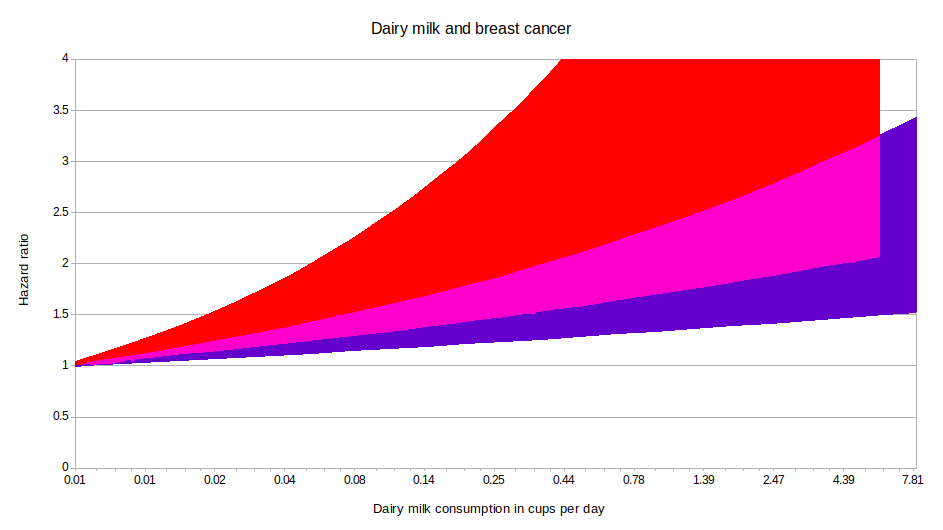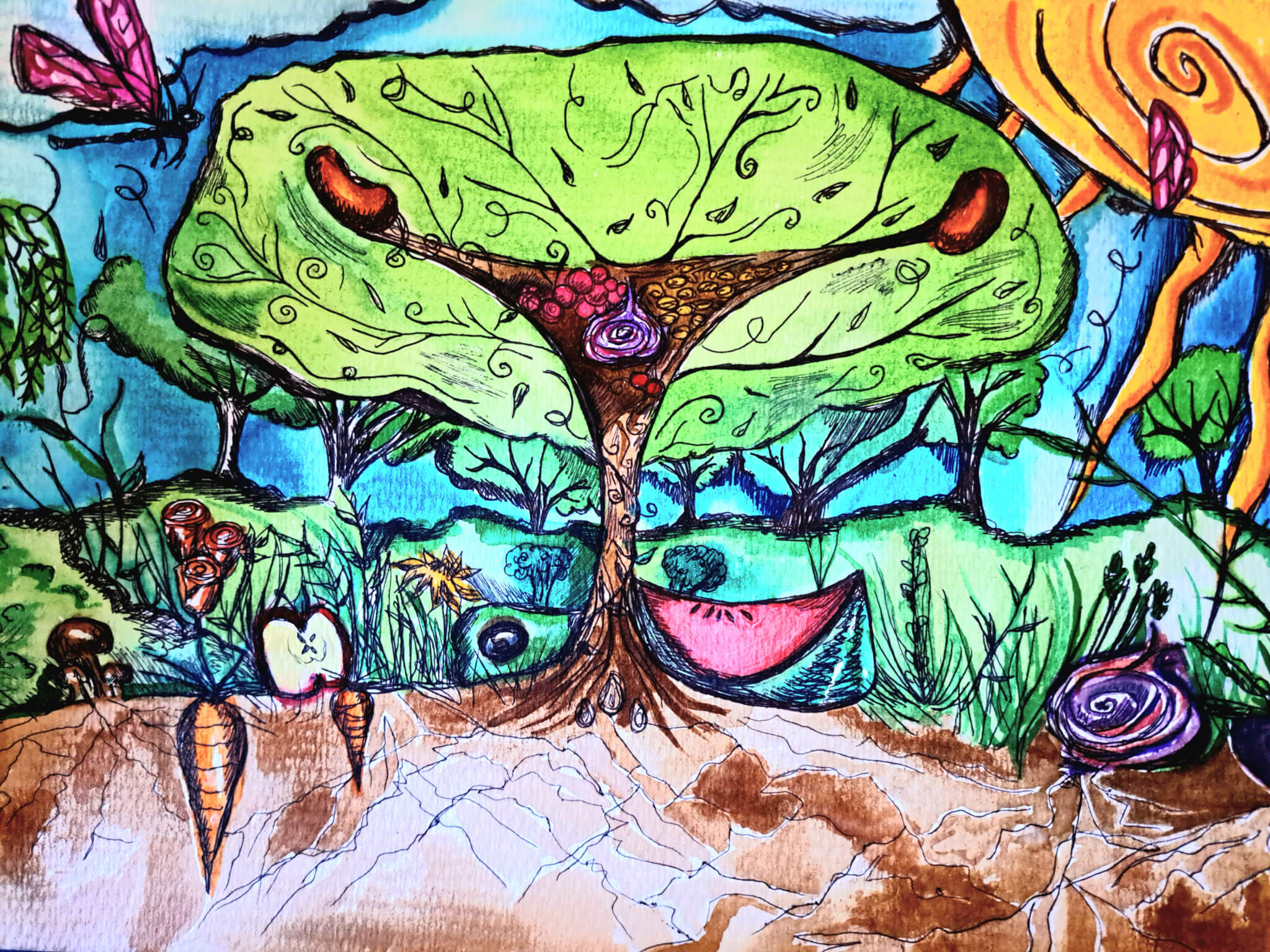The dairy and breast cancer connection
Vegan Society of Canada News
Published April 14th 2020
Updated April 16th 2020
A new study, funded by the World Cancer Research Fund (WCRF) and the National Cancer Institute at the National Institute of Health (NIH), finally sheds some light on the relation between dairy and breast cancer.
For many decades now, there has been inconclusive data with regards to dairy and first occurence breast cancer. It seems that for every study that showed a correlation, there were others that found no correlation and others that found a mild inverse correlation. All in all, it was difficult to make sense of anything. However, this new study finally provides the missing pieces of the puzzle and puts everything together.
We had the pleasure of discussing these results with the lead author, Dr. Gary Fraser of Loma Linda University. This analysis explains how this study is different, and why other studies have missed these correlations in the past.
The study looked at 52,795 North American women and found that dairy calories and milk, but not cheese and yogurt, were associated with 22 per cent and 50 per cent higher risk of breast cancer respectively. There was no correlation found between soy and breast cancer.
The increased risk started at a very low dairy usage of just ¼ cup of milk per day, or about 60 ml, and the increase was highest at less than 1 cup of milk per day with a strong rise in risk with up to ⅔ of a cup of milk per day.

Maximum likelihood regression and 95% confidence band uncalibrated log(dairy-milk kcal/day+1) against the hazard ratio (HR) of incident breast cancer in purple, 95% confidence band for the corresponding calibrated regression in red. Cups are 8 ounce size.
However, one of the largest and often cited meta-analyses on this topic, which looked at more than 1.5 million people from 22 prospective studies, found that not only did dairy not cause breast cancer, it even found a mild inverse relationship.
Why do we see so much conflicting research, and skip over other studies? Many times it’s because the research is not robust enough, and this is due to many factors.
Issues in research
There is a strong push in academia to publish papers, and the emphasis is generally on quantity over quality. We need replication studies, but they are not conducted often enough. It should not be too surprising since doing a lot of work to replicate someone else's work to confirm the initial result is not as glamorous as reporting something new—even though it may be incorrect. In today's infotainment society, accuracy and correctness take a back seat to eye catching and shock value.
Another factor is sample size; we see research being published with small sample sizes, which are pretty much meaningless, yet they still get picked up by the media.
Observational studies are often criticized. However, we must realize that for many scenarios, like evaluating the impact of a certain lifestyle, this is the best we have.
In addition, while we have to contend with misinformation, disinformation and propaganda from the animal agriculture sector, we also have to contend with similar problems from the plant based sector.
Another big debate in statistics is p-values. In short, the p-value tells us that if all our assumptions are correct and our modeling is correct, what is the likelihood of getting a result like we did if the null hypothesis is true. This threshold while arbitrary is crucial because it is used in many scientific fields to justify that their conclusions are sound. However, p-values are widely misunderstood.
We often see research using p-values of 0.05 as the gold standard, so much so that the American Statistical Association (ASA) issued a statement in 2016, and a follow-up article in 2019.
Suffice to say there are a lot of pitfalls. While many scientific fields are often content with p-values < 0.05, other scientific fields like physics operate at much lower values. For example, high-energy physics requires p <= 0.003 for ‘evidence of a particle’ and p <= 0.0000003 for ‘discovery’.
If we required these values in other scientific fields, there would be a drastic change. This would translate to requiring that scientific evidence of particle be rigorous enough to only have 1 out of 333 chances (and 1 in 3,333,333 for discovery) that the data we observed is likely if the null hypothesis is true, instead of 1 in 20. This is why the ASA suggestions for moving beyond p-values of 0.05 suggest these ideas:
Replace the 0.05 ‘statistical significance’ threshold for claims of novel discoveries with a 0.005 threshold and refer to p-values between 0.05 and 0.005 as ‘suggestive.’
Provide in addition an indication of false positive risk (FPR). This is the probability that the claim of a real effect on the basis of the p-value is in fact false. The FPR (not the p-value) is the probability that your result occurred by chance. For example, the fact that, under plausible assumptions, observation of a p-value close to 0.05 corresponds to an FPR of at least 0.2–0.3 shows clearly the weakness of the conventional criterion for ‘statistical significance’.
These FPR of 20–30% with a p-value close to 0.05 make it much easier to cheat and can lead to p-hacking. P-Hacking is when researchers try out many different statistical analyses and/or data manipulations until they obtain one with the desired p-value and only report those results as significant. Unfortunately, this is very difficult to detect if researchers are not being honest. Regrettably it happens, but the ASA is strongly against it:
Cherry-picking promising findings, also known by such terms as data dredging, significance chasing, significance questing, selective inference, and ‘p-hacking,’ leads to a spurious excess of statistically significant results in the published literature and should be vigorously avoided.
These are some of the generic factors which help explain why we see so much conflicting research.
Factors relevant to this case
Going back to our p-values, this meta-analysis unfortunately used p < 0.05 as an indication of statistical significance and used this to decide whether to include the study or not. On the other hand, Dr. Fraser’s research with regards to dairy milk calories when using regression calibration, produces p-value < 0.0001. To demonstrate the significance of this difference, even a study with p=0.04 both with prior probability of there being a real effect of 0.5 would generate a false positive risk (FPR) of 21.75%, whereas Dr. Fraser’s research in the case of dairy milk would generate a FPR 0.24%. This is a huge difference and one of the reasons, in addition to all the other pieces of the puzzle this research solves, that we are discussing it.
When we try to evaluate the impact of various factors, it is helpful to have a reference group which does not have this factor at all. For example, if we try to evaluate the impact of smoking and our reference group is made up of people who smoke every day, then depending on the shape of the hazard ratio curve we might end up on a flat part of the curve and report that we found no relation between smoking and cancer.
In our society, there are very few people who self-identify as vegans, around 1–3% depending where we are, therefore it is difficult for research to include a significant sample of vegans as a reference group in their observational study when looking at factors like dairy consumption. This is what happened in the Zang, et al. (2015) meta-analysis. The reference group was considered low dairy users at < 400gr/day, or less than 2 cups of milk per day. As the research from Dr. Fraser showed, the risk of breast cancer from milk starts at a very low level—a fraction of a cup per day—well below the levels that were used in the reference group. Therefore, it is clear that comparing risk between 3 groups—less than 2 cups, between 2 and 4 cups, and more than 6 cups of milk equivalent per day—completely misses the fact that the curve is at its steepest at a very low level of milk consumption.
This is one of the strengths of the AHS-2 cohort as it includes 8 per cent of people who self-identify as vegans, and 28 per cent vegetarians who consume dairy.
However, those vegetarians consume less dairy, about 60% of typical levels in the U.S. This allowed this new study to look at a statistically significant group of people with lower dairy consumption. On this topic the research paper states:
A hazardous effect of dairy is consistent with the recent AHS-2 report suggesting that vegans, but not lacto-ovo-vegetarians, experienced less breast cancer than non-vegetarians. Others have speculated that dairy is implicated in the marked increases in breast cancer in Japan since the Second World War, associated with a 20-fold increase in dairy consumption. These Japanese results may be the only other comparison between essentially zero intakes and much higher intakes, aside from the AHS-2 data.
Another issue with any such studies is they use food frequency questionnaires (FFQ). The exact inner workings of these are beyond the scope of this article, but for more details on FFQ, 24-hour dietary recall (24DR) and food records (FR) see this primer. In addition, for more details on the inaccuracies of 24DR and FFQ, see Slimani et al. (2003) and R J Carroll et al. (1997)
To fix some of these issues, some studies use a 24DR in a subgroup of the main group to calibrate the data. In this case, Dr. Fraser used, in addition to the recall procedure, some urinary tests to produce a more accurate result. However, here we notice another strength of having more people who self-identify as vegans for a reference group. When a person who self-identifies as vegans says they have not consumed any dairy in the last month, it’s guaranteed. The probability that this is a mistake is very low.
In addition, we all know that animal by-products are hidden everywhere under various names. Unfortunately, due to inadequate labelling regulations, people who self-identify as vegans had to reluctantly become label deciphering experts—but even we sometimes make mistakes. Therefore, for the average person, it not only becomes difficult to remember what was eaten, but they may also not be aware that they consumed animals or animal by-products. The sheer scale of this problem in research becomes clear in a survey published in 2017 that found 20 per cent of adults did not know that hamburgers were made from beef and 40 per cent of adults did not know that hamburgers came from cows.
The disinformation from the animal agriculture sector is very successful at hiding all the realities of our current food system from the public, making the risk of confusion high. All of this spills into research in various forms, like inaccurate FFQ. Nevertheless, we posit people who self-identify as vegans provide the best chance a research study has of finding people who, when they claim they did not consume animals or animal by-products, they in reality did not.
As more and more people adopt veganism, we strongly encourage researchers to include more of them in their study to act as a reference group when appropriate. Scientifically, it provides a much better picture to compare the entire spectrum of intake instead of merely a subset as we risk missing crucial information, which happened in the case of Zang, et al. (2015).
Another issue with the meta-analysis of Zang, et al. (2015) is that it combined all dairy types. However, as in Dr. Fraser’s study that showed cheese and yoghurt had no correlation, previous studies that looked at overall dairy may have hidden the cancer causing properties of milk in the entire dairy group. In our discussion, Dr. Fraser mentioned that this would be part of further investigation to get additional insights into the exact cause of this correlation. In the meantime, the study posits that hormones in milk may be responsible for this increase in cancer risk.
We often hear disinformation with regards to Canadian milk not containing hormones. As we have already discussed, this is false. All milk contains various bovine sex hormones like progesterone, testosterone, and various estrogen types like estrone, estriol and estradiol. In addition to sex hormones, milk contains other hormones like prolactin, insuline growh factor 1 (IGF-1), glucocorticoids and various prostaglandins like PGE2, PGD2, PGF2, PGI2, and Tromboxan A2. For a more in depth discussion of all hormones in dairy foods, see this article.
This would also be coherent with the fact that cheese and yoghurt did not have any cancer correlation, as they have lower levels of hormones than milk. This is perhaps because the hormones are denatured as a result of various processes like ageing in the case of cheese. We discussed with Dr. Fraser the significance of sex hormones in animals affecting prostates in men and breasts in women. The relation is interesting but remains largely unexplored. Dr. Fraser and his colleagues are also working on other research looking more into dairy with regards to prostate cancer. We are also interested in research that would take into account prostate enlargement in men; while mostly not deadly, it is nevertheless the cause of many problems in men as they age:
Benign prostatic hyperplasia affects about 50 percent of men between the ages of 51 and 60 and up to 90 percent of men older than 80.2.
We want to see research also taking into account prostate hyperplasia since if dairy causes prostate cancer, it is certainly plausible that it may also be responsible for prostate hyperplasia. If it turns out that dairy is not only causing prostate cancer but also prostate enlargement, it would be a significant finding. For example, if 20 per cent of dairy users develop prostate cancer and the remaining 80 per cent develop prostate enlargement, that would be extremely important information to have. Dr. Fraser is also interested in this question, and we hope this aspect will be included in his current research on prostate cancer.
Conclusion
There are health professionals who claim to care about human animal health, but they have yet to understand that human animal health, the health of all animals and of the environment are inextricably linked. It is already estimated that many millions of people will die this year due to climate change alone; add to that the countless non-human animals who will perish for the same reason.
Health Canada, in their latest food guide, reminds all Canadians that human animals do not exist in a vacuum:
Food choices can have an impact on the environment. While health is the primary focus of Canada’s Dietary Guidelines, there are potential environmental benefits to improving current patterns of eating as outlined in this report. For example, there is evidence supporting a lesser environmental impact of patterns of eating higher in plant-based foods and lower in animal-based foods. The potential benefits include helping to conserve soil, water and air. The way our food is produced, processed, distributed, and consumed—including food loss and food waste—can also have environmental implications.
Dr. Fraser’s research on the correlation between milk and breast cancer is the strongest evidence we have seen to date, and it explains why other studies have missed this correlation in the past. We want to thank Dr. Fraser and his colleagues for their time, and the World Cancer Research Fund for helping fund this important research. We look forward to learning more about the cause behind cancer and other benign illnesses in future publications.
We encourage other researchers to try and replicate the result of this research. A good cohort for a replication study would be the EPIC cohort using a vegan reference group, or the EPIC-Oxford cohort.
At about 4 per cent, it falls short of the 8 per cent of vegans in the AHS-2 cohort, nevertheless it should be possible to form a statistically significant group of vegans among the entire EPIC cohort to act as a reference group.
It’s been unethical for many years to recommend milk to people based on health concerns, and other factors. We have covered the health concerns in the past, and have updated our article to reflect these latest findings.
There is no version of ethics that would allow recommending cow’s milk to humans. Animal agriculture brings little to no benefit to our society and is the cause of many problems, including being a major cause of climate change and pandemics along with the suffering and killing of countless animals, including human animals. Joins us in making animal agriculture something future generations will read about in history books.
A change of lifestyle offers individuals a powerful means to combat a range of issues, including personal health problems, climate change, loss of biodiversity, global acidification, eutrophication, freshwater shortages, pandemic prevention, antibiotic resistance, save countless lives and much more. We know of no other efficient way for individuals to address these critical challenges simultaneously without waiting for government, corporate, or technological interventions. By changing lifestyle, people can take immediate and impactful action. We encourage you to embrace this lifestyle change today. Contact us for support and to connect with local communities in your area.




